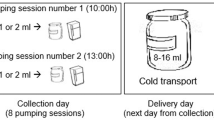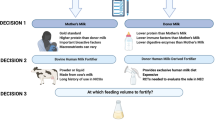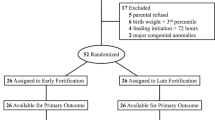Abstract
We hypothesized that premature (PT) infants' mother's milk may provide antioxidant advantages compared with milk from mothers of full-term (FT) infants, and human milk may provide antioxidant properties not seen in infant formulas. We designed three experiments to test these hypotheses. Experiment 1 assessed resistance to oxidative stress of human milk and formulas designed for FT and PT infants. Experiment 2 determined differences in resistance to oxidative stress between milk from mothers of FT and PT infants, including analysis of catalase activity. Experiment 3 examined factors in human milk that may account for increased resistance to oxidative stress. In experiment 1, we induced physiologic oxidative stress in human milk (n = 5) and formula (n = 2) and measured ascorbate radical using electron paramagnetic resonance. Results indicated the following: 1) during oxidative stress, ascorbate may be spared in human milk compared with formula; 2) ascorbate radical production is more intense in formula compared with human milk, with or without oxidative stress; and 3) oxygen consumption in human milk is less than that in formula, with or without oxidative stress. In experiment 2, milk samples were collected from mothers of PT (n = 28) and FT (n = 17) infants at wk 1, 2, and 12 of lactation. No differences in oxygen consumption after oxidative stress appeared between PT and FT milk. Catalase levels in human milk increased with time. In experiment 3, addition of catalase, superoxide dismutase, and glutathione peroxidase to formulas (n = 4) increased resistance to oxidative stress. Denaturing endogenous enzymes did not decrease the ability of human milk to resist oxidative stress. Ferrous sulfate plus vitamin C added to human milk and formulas fortified with iron increased oxidative stress. Addition of iron chelators to formula reduced oxidative stress. In conclusion, human milk has better antioxidant protection than do formulas, perhaps because of the higher iron content of formulas. Milk from mothers of PT and FT infants has equal resistance to oxidative stress.
Similar content being viewed by others
Log in or create a free account to read this content
Gain free access to this article, as well as selected content from this journal and more on nature.com
or
Abbreviations
- CAT:
-
catalase
- DETAPAC:
-
diethylenetriaminepentaacetic acid
- EPR:
-
electron paramagnetic resonance alias ESR
- ESR:
-
electron spin resonance alias EPR
- FT:
-
full-term
- GPx:
-
glutathione peroxidase
- HM:
-
human milk
- HX:
-
hypoxanthine
- MDA:
-
malondialdehyde
- PT:
-
premature
- SOD:
-
superoxide dismutase
- XO:
-
xanthine oxidase
References
Anderson GH 1985 Human milk feeding. Pediatr Clin North Am 32: 335–353
Goldman AS, Goldblum RM 1995 Defence agents in human milk. In: Jensen R (ed) Handbook of Milk Composition. Academic Press, San Diego, 727–745
Goldman AS, Thorpe LW, Goldblum RM, Hanson KA 1986 Anti-inflammatory properties of human milk. Acta Paediatr Scand 75: 689–695
Buescher ES, McIlherhan SM 1988 Antioxidant properties of human colostrum. Pediatr Res 24: 14–19
L'Abbe M, Friel JK 2000 Superoxide dismutase and glutathione peroxidase content of human milk from mothers of premature and full-term infants during the first 3 months of lactation. J Pediatr Gastroenterol Nutr 31: 270–274
Goldman AS, Goldblum RM, Hanson KA 1990 Anti-inflammatory systems in human milk. Adv Exp Med Biol 262: 69–76
Van Zoeren-Grobben D, Lindeman JH, Houdkamp E, Brand R, Schrijver J, Berger HM 1994 Postnatal changes in plasma chain-breaking antioxidants in healthy preterm infants fed formula and/or human milk. Am J Clin Nutr 60: 900–906
Lonnerdal B, Atkinson SA 1995 Nitrogenous components of milk. In: Jensen R (ed) Handbook of Milk Composition. San Diego, Academic Press, 351–368
Abbott Laboratories 1999 Composition of Feedings for Infants and Young Children. Ross Products Division, Columbus, OH, 1–17
Buettner GR, Jurkiewicz BA 1993 Ascorbate free radical as a marker of oxidative stress: an EPR study. Free Radic Biol Med 14: 49–55
Omaye ST, Turnbull JD, Sauberlich HE 1979 Selected methods for the determination of ascorbic acid in animal cells, tissues and fluids. Methods Enzymol 62: 3–11
Altman PL, Gibson JF Jr, Wang CC 1958 Handbook of Respiration. Wright Air Development Center, Fairborn, Ohio
Lepage G, Munoz G, Champagne J, Roy CC 1991 Preparative steps necessary for the accurate measurement of malondialdehyde by high-performance liquid chromatography. Anal Biochem 197: 277–283
Hirvi Y, Griffiths MW 1998 Milk catalase activity as an indicator of thermization treatments used in the manufacture of cheddar cheese. J Dairy Sci 81: 338–345
Inder TE, Graham P, Sanderson K, Taylor BJ 1994 Lipid peroxidation as a measure of oxygen free radical damage in the very low birthweight infant. Arch Dis Child 70: F107–F111
Saugstad OD 1988 Hypoxanthine as an indicator of hypoxia: its role in health and disease through free radical production. Pediatr Res 23: 143–150
Sullivan JL 1988 Iron, plasma antioxidants and the “oxygen radical disease of prematurity.”. Am J Dis Child 142: 1341–1344
Atkinson SA 1995 Effect of gestational stage at delivery on human milk components. In: Jensen R (ed) Handbook of Milk Composition. San Diego, Academic Press, 222–234
Heyndrickx GV 1963 Further investigations on the enzymes in human milk. Pediatrics 31: 1019–1023
Marshall TA, Roberts RJ 1990 In vitro and in vivo assessment of lipid peroxidation of infant nutrient preparations; effect of nutrition on oxygen toxicity. J Am Coll Nutr 9: 190–199
Brown EG, Sweet AY 1982 Neonatal necrotizing enterocolitis. Pediatr Clin North Am 29: 1149–1170
Lucas A, Cole TJ 1990 Breast milk and necrotizing enterocolitis. Lancet 336: 1519–1523
Cunningham AS 1987 Breast feeding, antioxidants and the retinopathy of prematurity. Am J Obstet Gynecol 156: 1040–1041
Pitt J, Barlow B, Heird WC 1977 Protection against experimental necrotizing enterocolitis by maternal milks. 1. Role of milk leucocytes. Pediatr Res 11: 906–909
Narayanan I, Prakash K, Gujral VV 1981 The value of human milk in the prevention of infection in the high-risk low-birth-weight infant. J Pediatr 99: 496–498
Almaas R, Rootwelt T, Oyasaeter S, Saugstadt D 1997 Ascorbic acid enhances hydroxyl radical formation in iron-fortified infant cereals and infant formulas. Eur J Pediatr 156: 488–492
Van Zoeren-Grobben D, Moison RM, Ester WM, Berger HM 1993 Lipid peroxidation in human milk and infant formula: effect of storage, tube feeding and exposure to phototherapy. Acta Paediatr Scand 82: 645–649
Buescher ES, McIlherhan SM, Frenck RW 1989 Further characterization of human cholesterol antioxidants: identification of an ascorbate like element as an antioxidant component and demonstration of antioxidant heterogeneity. Pediatr Res 25: 266–270
Rosenfeld W, Evans H, Concepcion L, Jhaveri R, Schaeffer H, Friedman A 1984 Prevention of bronchopulmonary displasia by administration of bovine superoxide dismutase in preterm infants with respiratory distress syndrome. J Pediatr 105: 781–785
Herbert V, Shaw S, Jayatilleke E, Stopler-Kasdan T 1994 Most free radical injury is iron related: it is promoted by iron, hemin, holoferritin, and vitamin C, and inhibited by desferoxamine and apoferritin. Stem Cells 12: 289–303
Qian SY, Buettner GR 1999 Iron and dioxygen chemistry is an important route to initiation of biological free radical oxidations: An electron paramagnetic resonance spin trapping study. Free Radic Biol Med 26: 1447–1456
Buettner GR, Jurkiewicz BA 1996 Catalytic metals, ascorbate, and free radicals: combinations to avoid. Radiat Res 145: 532–541
Raghuveer T, McGuire EM, Wagner BA, Buettner GR, Widness JA 2001 Lactoferrin (Lf) supplementation can reduce iron-induced oxidative stress (abstract 1675). In: Program of the Pediatric Academic Societies and American Academy of Pediatrics Joint Meeting, Baltimore, MD, U.S.A., April 28–May 1, 2001. Lippincott Williams & Wilkins, Baltimore, vol. 49, 293A
Acknowledgements
The authors thank Dr. Freya Schaefer, Dr. Steven Qian, Brett R. Wagner, Allison MacDonald, and Claude Mercer for their technical assistance, as well as all the mothers who participated and Drs. Wayne Andrews and Khalid Aziz for their critical advice. We also thank the nurses at the Iowa Clinical Research Center and Jack Widness for their assistance.
Author information
Authors and Affiliations
Corresponding author
Additional information
Supported by Grant RR00059 from the General Clinical Research Center Program, National Center for Research Sciences, NIH; Grant 66081 from the National Institutes of Health; and Grant 146833 from the Canadian Institutes of Health Research.
Rights and permissions
About this article
Cite this article
Friel, J., Martin, S., Langdon, M. et al. Milk from Mothers of Both Premature and Full-Term Infants Provides Better Antioxidant Protection than Does Infant Formula. Pediatr Res 51, 612–618 (2002). https://doi.org/10.1203/00006450-200205000-00012
Received:
Accepted:
Issue date:
DOI: https://doi.org/10.1203/00006450-200205000-00012
This article is cited by
-
Association between adherence to a low carbohydrate dietary (LCD) pattern with breast milk characteristics and oxidative markers in infants’ urine: a cross-sectional study
Journal of Health, Population and Nutrition (2023)
-
Maternal Adherence to a Dietary Approaches to Stop Hypertension (DASH) Dietary Pattern and the Relationship to Breast Milk Nutrient Content
Maternal and Child Health Journal (2023)
-
Dose-dependent effect of human milk on Bronchopulmonary dysplasia in very low birth weight infants
BMC Pediatrics (2020)
-
Systematic review and meta-analysis of human milk intake and retinopathy of prematurity: a significant update
Journal of Perinatology (2016)
-
Timing of solid food introduction is associated with urinary F2-isoprostane concentrations in childhood
Pediatric Research (2015)



